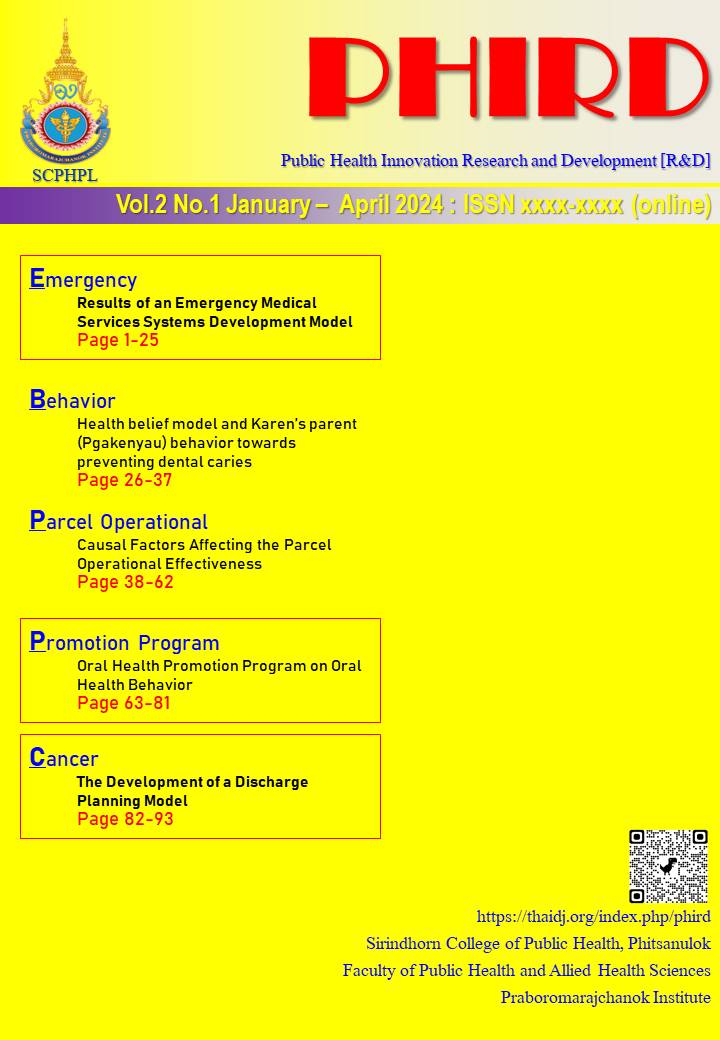The Development of a Discharge Planning Model for End-Stage Lung Cancer Patients Wishing to Die at Home
Keywords:
Discharge planning model, End-stage lung cancer, End-Stage Lung Cancer Patients Wishing to Die at HomeAbstract
ABSTRACT
Background: Cancer is currently one of the major public health problems in the world. The most common problem is caring for cancer patients, where patients and their relatives often lack the readiness to face the end-stage changes of the disease and a handful of patients wish to die at home.
Aim: to develop a discharge planning model for end-stage lung cancer patients wishing to die at home.
Methods: 30 persons used purposive sampling. The instrument was a questionnaire that the researcher created, the validity (IOC) equals 0.67-1.00, and the reliability equals 0.75; the data were analyzed using percentage frequency and content analysis.
Results: The discharge planning model takes 3-5 days. There are 3 topics, 1) Advance planning consists of an Advance Care Plan, Family meeting, and Discharge Planning. 2) Inpatient Care consists of Nursing care according to circumstances, Symptom Management, Counseling process, and Health Education. 3) Continuing care consists of home visits, Counseling patients and relatives over the phone, and Bereavement Care. Patients and caregivers had the highest satisfaction with the patient discharge planning model in terms of 1) advance planning (57.78%) 2) hospital care (65.56%), and 3) continuing care (60%).
Conclusion: Planning helps prepare to serve patients effectively. Taking care of patients throughout their time in the hospital helps patients recover faster. Providing continuous services to patients and their families helps patients to be as self-reliant as possible.
Keywords: Discharge planning model, End-stage lung cancer, End-Stage Lung Cancer Patients Wishing to Die at Home
References
กิ่งกาญจน์ ชุ่มจำรัส และ เพชรน้อย สิงห์ช่างชัย. (2561). ผลของโปรแกรมการวางแผนจำหน่ายร่วมกับให้
ครอบครัวมีส่วนร่วม ในการดูแลผู้ป่วยเจาะคอ ต่อความรู้ความสามารถของผู้ดูแลผู้ป่วยเจาะคอ และความพึงพอใจของผู้ดูแลในหอผู้ป่วย ตา หู คอ จมูก โรงพยาบาลสงขลา. วารสารเครือข่ายวิทยาลัยพยาบาลและวิทยาลัยการสาธารณสุขภาคใต้. 2561; 5(1) 124-134.
มหาวิทยาลัยมหิดล. (2562). นโยบายการต่อสู้กับโรคมะเร็งที่ถูกต้องเพื่อลดอุบัติการณ์ ลดภาวะทุพพลภาพ
และการเสียชีวิตจากมะเร็งในประเทศไทย. https://www.si.mahidol.ac.th/th/
hotnewsdetail.asp?hn_id=2422
พาศนา บุณยะมาน. ผลการวางแผนจำหน่ายผู้ป่วยผ่าตัดมะเร็งเต้านมแบบถอนรากชนิดดัดแปลงพร้อมขวด
ระบายสุญญากาศต่อความสามารถในการดูแลตนเอง ภาวะแทรกซ้อน และความพึงพอใจ หอผู้ป่วยศัลยกรรมหญิง โรงพยาบาลสงขลา. วารสารสมาคมเวชศาสตร์ป้องกันแห่งประเทศไทย. 2560;
(1) 95 - 103
รัตนาภรณ์ แซ่ลิ้ม นงลักษณ์ ว่องวิษณุพงศ์ และ สุดจิต ไตรประคอง. ประสิทธิผลของโปรแกรมการวางแผน
จำหน่ายต่อความรู้และพฤติกรรมการดูแลตนเองในผู้ป่วยโรคหลอดเลือดแดงส่วนปลายอุดตันใน โรงพยาบาลสงขลานครินทร์.วารสารสภาการพยาบาล 2557; 29 (2) 101-113
โรงพยาบาลมะเร็งอุดรธานี. รายงานประจำปี 2562. โรงพยาบาลมะเร็งอุดรธานี.
วิมาลา อินด้วง และหทัยรัตน์ ใจวังเย็น. การพัฒนาแนวปฏิบัติทางการพยาบาลสําหรับการวางแผนจําหน่ายใน
ผู้ป่วยศัลยกรรมประสาทที่ได้รับการดูแลแบบประคับประคองในระยะเปลี่ยนผ่าน และระยะสุดท้ายของชีวิต โรงพยาบาลมหาราชนครเชียงใหม่. เชียงใหม่เวชสาร. 2563; 59(3) 149 – 161
Rattanaporn Saelim, Nongluck Vongwisanupong, and Sudchit Triprakong. (2014). Effectiveness
of a Discharge Planning Programme on Self-Care Knowledge and Behavior of Peripheral Arterial Occlusion Patients at Songkhla Nakharin Hospital. https://he02.tci-thaijo.org/index.php/TJONC/article/view/21122/18302
Jiraporn Phothichai. (2014). Development of Discharge Planning Guidelines for Elderly
Patients with Continuous Ambulatory Peritoneal Dialysis, Roi-Ed Hospital. http://digital_collect.lib.buu.ac.th/dcms/files/54920235.pdf
Thapanee Khumdinphithak. (2013). Development of Clinical Nursing Practice Guidelines for
Discharge Planning of the Elderly with Hypertension Disease in Medical Wards, Kalasin
Hospital, Kalasin Province. http://digital_collect.lib.buu.ac.th/dcms/files/54920237.pdf
Pasna Boonyamarn. (2018). The Effect of Discharge Planning for Modified Radical
Mastectomy Patients with Redivac Drain on Self-Care, Complication, and Satisfaction at Female Surgical Ward, Songkhla Hospital. https://he01.tci-thaijo.org/
index.php/JPMAT/article/view/128085
Mary O'Brien and Barbara Jack. (2009). Barriers to dying at home: the impact of poor
coordination of community service provision for patients with cancer. https://pubmed.ncbi.nlm.nih.gov/20039968/
Downloads
Published
How to Cite
Issue
Section
License
Copyright (c) 2024 Public Health Innovation Research and Development - การวิจัยและพัฒนานวัตกรรมสาธารณสุข

This work is licensed under a Creative Commons Attribution-NonCommercial-NoDerivatives 4.0 International License.
This journal is published under the terms of the Creative Commons Attribution 4.0 International (CC-BY-NC-ND 4.0) by Sirindhorn College of Public Health Phitsanulok, Faculty of Public Health and Allied Health Sciences, Praboromarajchanok Institute, Ministry of Public Health, Thailand





